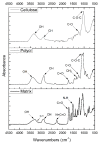Bio-Based Polyurethane Composites and Hybrid Composites Containing a New Type of Bio-Polyol and Addition of Natural and Synthetic Fibers
- PMID: 32357478
- PMCID: PMC7254400
- DOI: 10.3390/ma13092028
Bio-Based Polyurethane Composites and Hybrid Composites Containing a New Type of Bio-Polyol and Addition of Natural and Synthetic Fibers
Abstract
This article describes how new bio-based polyol during the liquefaction process can be obtained. Selected polyol was tested in the production of polyurethane resins. Moreover, this research describes the process of manufacturing polyurethane materials and the impact of two different types of fibers-synthetic and natural (glass and sisal fibers)-on the properties of composites. The best properties were achieved at a reaction temperature of 150 °C and a time of 6 h. The hydroxyl number of bio-based polyol was 475 mg KOH/g. Composites were obtained by hot pressing for 15 min at 100 °C and under a pressure of 10 MPa. Conducted researches show the improvement of flexural strength, impact strength, hardness, an increase of storage modulus of obtained materials, and an increase of glass transition temperature of hard segments with an increasing amount of fibers. SEM analysis determined better adhesion of sisal fiber to the matrix and presence of cracks, holes, and voids inside the structure of composites.
Keywords: biomass liquefaction; glass fiber; hybrid composites; polymer matrix composites (PMCs); scanning electron microscopy (SEM); sisal fiber.
Conflict of interest statement
The authors declare no conflict of interest.
Figures


















References
-
- Kosmela P., Kazimierski P., Formela K., Haponiuk J., Piszczyk Ł. Liquefaction of macroalgae Enteromorpha biomass for the preparation of biopolyols by using crude glycerol. J. Ind. Eng. Chem. 2017;56:399–406. doi: 10.1016/j.jiec.2017.07.037. - DOI
-
- Ma R., Li W., Huang M., Feng M., Liu X. The reinforcing effects of dendritic short carbon fibers for rigid polyurethane composites. Compos. Sci. Technol. 2019;170:128–134. doi: 10.1016/j.compscitech.2018.11.047. - DOI
-
- Bledzki A.K., Gassan J. Composites reinforced with cellulose based fibers. Prog. Polym. Sci. 1999;24:221–274. doi: 10.1016/S0079-6700(98)00018-5. - DOI
-
- Rahman R., Putra S.Z. Mechanical and Physical Testing of Biocomposites, Fibre-Reinforced Composites and Hybrid Composites. Woodhead Publishing; Cambridge, UK: 2019. Tensile properties of natural and synthetic fiber-reinforced polymer composites. - DOI
-
- Li S., Vatanparast R., Lemmetyinen H. Cross-linking kinetics and swelling behavior of aliphatic polyurethane. Polymer. 2000;41:5571–5576. doi: 10.1016/S0032-3861(99)00785-5. - DOI
Grants and funding
LinkOut - more resources
Full Text Sources

